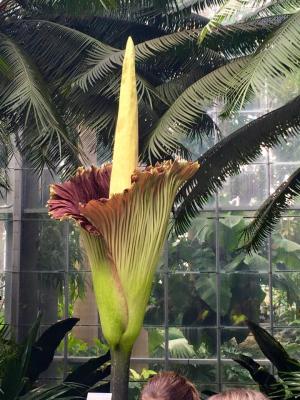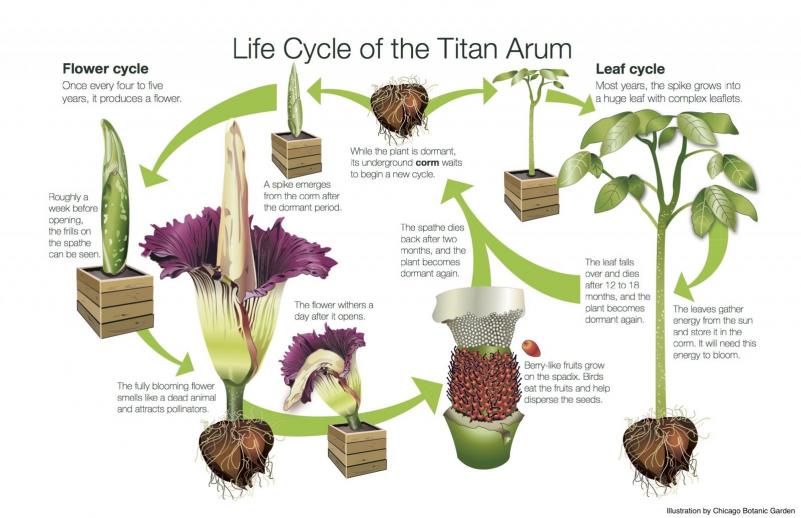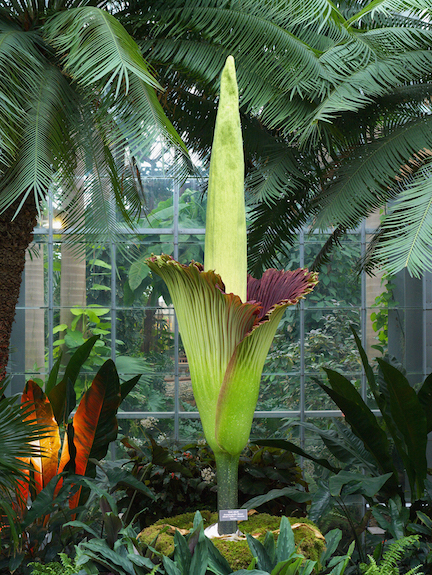 The corpse flower (Amorphophallus titanum), also known as the stinky plant, bloomed August 2-5, 2016 at the U.S. Botanic Garden Conservatory. It was the first bloom of this particular plant, which was six years old. It takes quite a while to create enough energy for a bloom as spectacular as this one!
The corpse flower (Amorphophallus titanum), also known as the stinky plant, bloomed August 2-5, 2016 at the U.S. Botanic Garden Conservatory. It was the first bloom of this particular plant, which was six years old. It takes quite a while to create enough energy for a bloom as spectacular as this one!
The plant went on view to the public Friday, July 22. The bloom began opening early Tuesday morning, August 2, and collapsed Friday, August 5, 2016. It stood 7'4".
The magic of the titan arum comes from its great size - it is largest unbranched inflorescence in the plant kingdom. When it went on display, the plant was around 3.5 feet tall. Referred to as the corpse flower or stinky plant, its putrid smell is most potent during peak bloom at night into the early morning. The odor is often compared to the stench of rotting flesh. The inflorescence also generates heat, which allows the stench to travel further. This combination of heat and smell efficiently attracts pollinators, such as carrion beetles and flies, from across long distances.
The titan arum does not have an annual blooming cycle. The titan arum emerges from, and stores energy in, a huge underground stem called a "corm." The plant blooms only when sufficient energy is accumulated, making time between flowering unpredictable, spanning from a few years to more than a decade. It requires very special conditions, including warm day and night temperatures and high humidity, making botanic gardens well suited to support this strange plant outside of its natural range.
This plant is native to the tropical rainforests of Sumatra, Indonesia, and first became known to science in 1878. In its natural habitat, the titan arum can grow up to 12 feet tall. Public viewings of this unique plant have occurred a limited number of times in the United States. The U.S. Botanic Garden previously displayed blooming titan arums in 2003, 2005 and 2007, 2010, and 2013.
See a time lapse of this corpse flower growing, blooming, and collapsing. And keep your eyes open at the end to see inside, where the hundreds of male and female flowers are hidden.
Chemistry of its smell
Want to learn a bit more about the plant and its unique smell? Check out this great video we helped create:
We shared the 2016 plant's life cycle via a live webcam, which has now ended. In addition to this video from the morning it started opening, August 2, 2016, you can find all the live webcam videos on our YouTube channel. If you visited, find your date and see yourself with the corpse flower!
Photo of 2013 corpse flower bloom:
The U.S. Botanic Garden last displayed a corpse flower bloom in 2013. More than 130,000 people came to see the plant in person, and more than 650,000 viewers accessed the live webstream.
Learn more about the 2013 bloom.



